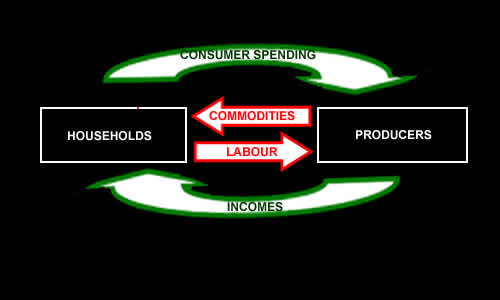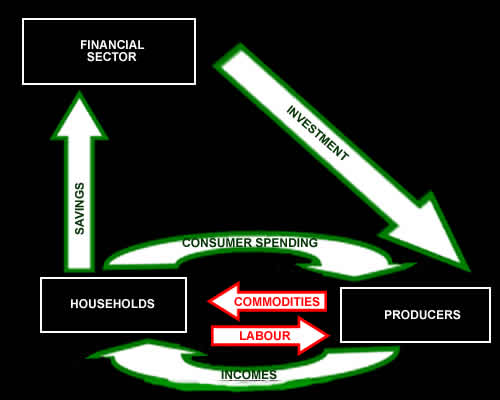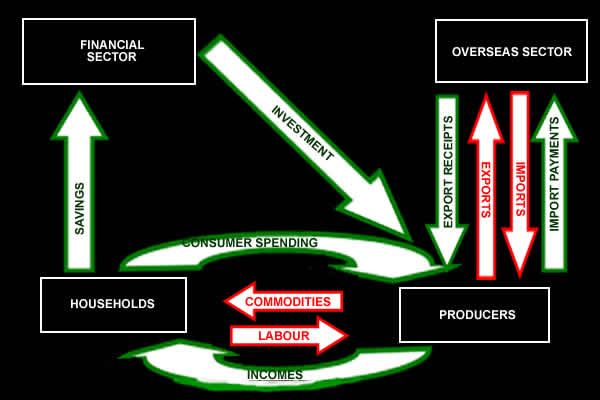| The Circular Flow of the Economy. | |||||
|
Objectives: By the end of this section you will be able to:-
|
|||||
| The
circular flow model shows how the FIVE different sectors of the economy are
linked. We will be looking at both money flows and real flows. Real Flows look at the flow of physical things through the economy. In the Circular Flow Model they are - Labour (the flow of resources. - Commodities - Exports - Imports Money Flows look at the flow of money through the economy. Some of the money flows are linked to real flows. In the Circular Flow Model they are - Income (linked with labour) - Consumer spending or consumption spending (linked with commodities). - Savings - Investment or Venture Finance. - Government Spending - Taxes - Transfer Payments - Subsidies - Export Receipts (linked with Exports) - Import Payments (linked with Imports). |
|||||
Households and producers |
|||||
| Households and producers rely on each other. Households rely on Producers for Income and Commodities and Producers rely on Households for Labour and Consumption Spending. There is a mutual dependence - they are interdependent. Households rely on producers for Income and Commodities and produicers rely on households for Labour and Consumer Spending. | |||||
| SIMPLE CIRCULAR FLOW MODEL SHOWING BOTH REAL AND MONEY FLOWS | |||||
 |
|||||
| THE
RESOURCE MARKET This the market that corresponds with the real flow of labour. |
|||||
| Households are the owners of the resources | |||||
|
|||||
| Income
includes wages, salaries etc. If Income increases then consumers will spend more meaning that profits for firms will increase leading to more employment and greater spending in the economy. The opposite will happen if income is reduced. |
|||||
Financial sector |
|||||
| Most people do not spend all their income. Some is saved for future buying. Savings can be deposited in banks or other firms in the financial sector and earn interest. As income increases people tend to save more. | |||||
| The
Financial Sector use these savings to make
loans to producers wanting to expand e.g. more buildings, machinery or for
a farmer more land, stock, and fertilizer etc. This is called investment. Investment in Economics is the buying of capital goods, this means the buying of machinery or buildings or anything that is used in the production process and is man made. The Financial Sector acts as an intermediary between households (with savings to be invested) and producers (who need money to invest). Investment from the financial sector to producers can also be in the form of Venture Finance. Producers are borrowing to invest in new businesses or or expansion. |
|||||
| The Financial Sector makes a profit from the difference between the interest rate they pay savers (e.g. 5 percent) and the interest rate they charge producers (e.g. 7 percent). | |||||
| The financial sector acts as an intermediary between households who want to save money and firms who want to borrow money for investment. | |||||
| SIMPLE CIRCULAR FLOW MODEL INCLUDING THE FINANCIAL SECTOR | |||||
 |
|||||
| What would happen if the financial sector were removed from the Circular Flow? | |||||
|
|
|||||
Overseas sector |
|||||
| NZ exports a number of goods and services overseas, these include dairy products, beef, lamb, tourism, etc. The exports are part of the real flow. Export Receipts is the money flow that corresponds with the real flow. | |||||
|
|
|||||
| Money flows into NZ producers for exports (export receipts) and out of NZ to overseas suppliers as payment for our Imports. | |||||
| The balance of payments is a measure of how much money is leaving NZ compared to how much money is entering NZ. It shows Export Receipts minus Import Payments. The Balance of Payments records if there is a surplus i.e. Export receipts exceed Import payments; or a deficit i.e. Import payments exceed export receipts. If a deficit results then NZ must borrow the difference overseas. | |||||
 |
|||||
| |||||
|
Source: Statistics New Zealand, September 2005. |
|||||
| |||||
Government sector | |||||
| Government spending is large on services like education, health, roads, police, defence etc. | |||||
| This must be added to consumer spending to give total spending on goods and services. Government spending comes from money collected as taxes. | |||||
| Income tax is paid by all wage and salary earners. It is mostly paid using P.A.Y.E. (Pay As You Earn) and is automatically deducted from wages. Income after tax is called disposable income. | |||||
| Company tax must be paid on all profits by firms, including banks (the financial sector). These are direct taxes. | |||||
| Indirect taxes like GST also provide money. GST (12.5% of the price) is paid by producers on all goods and services sold. This increases firm costs, although part of the extra cost is passed on to consumers in a higher price. Indirectb taxes also include excise taxes. These are taxes on alcohol, tabacco etc. and are used to try and discourage their consumption. | |||||
| Subsidies
These are paid to producers to help
them to produce a certain type of good or service the Government believes
should be produced more. Subsidies enable firms to produce more, charge a lower price, and
thereby sell more. In NZ things like the Royal New Zealand Ballet are
subsidised by the Government. Transfer Payments These are paid to Households in the form of money transfers like benefits. These are paid to help people who may be sick or in between work.
| |||||
| |||||
| |||||
 |
|||||
Example: | |||||
| A lot of T.V. programmes made in NZ for NZ television are subsidised by the Government. This is to help encourage NZ producers to make NZ programmes in order to let New Zealanders be able to watch NZ television on T.V. | |||||
| |||||
Interdependence | |||||
| All the sectors depend on each other and none could operate
fully without the other sectors e.g. government is needed to provide
services not provided by producers and to assist the needy. The money for government comes from households, producers and banks. | |||||
| All the sectors are interdependent - they are mutually reliant, they all rely on each other. | |||||
| For example. | |||||
| The household sector and the producer sector are interdependent. Households rely on producers for income and commodities. Producers rely on households for labour (resources) and consumer spending. They rely on each other,; they are interdependent. | |||||
| Explain how the government and households are interdependent | |||||
| Gross Domestic Product - GDP |
|||||
| This is the value of all goods and services produced in an economy in a given year and consists of the money flows within the economy. | |||||
| GDP = Income in the economy. AND GDP = Consumption + Investment + Government Spending + (Exports - Imports) |
|||||
| When the economy is growing rapidly and GDP is increasing this is called a boom. | |||||
| When the economy is growing slowly and GDP is growing at a very slow rate or not at all it is called a recession. | |||||
| When the economy is getting smaller (negative growth) it is called a depression. | |||||
| The Impact Of Changes On The Circular Flow | |||||
|
INJECTION OF MONEY INTO THE CIRCULAR FLOW. If money is put into the Circular Flow then this will flow onto other areas of the economy. Injections of money include.
Any increase in any of these factors will lead to an increase in production, more employment, greater incomes and increased consumer spending. The economy will experience a boom. e.g. An increase in export receipts.
| |||||
|
WITHDRAWAL OF MONEY FROM THE CIRCULAR FLOW. If money is taken out of the Circular Flow then this will flow onto other areas of the economy. Withdrawals of money include.
Any increase in any of these factors will lead to an decrease in production, less employment, smaller incomes and decreased consumer spending. The economy may experience a recession. An increase in imports will have the opposite effect of the one shown above. An appeciation of the New Zealand dollar will cause an increase in imports and a fall in exports.
| |||||